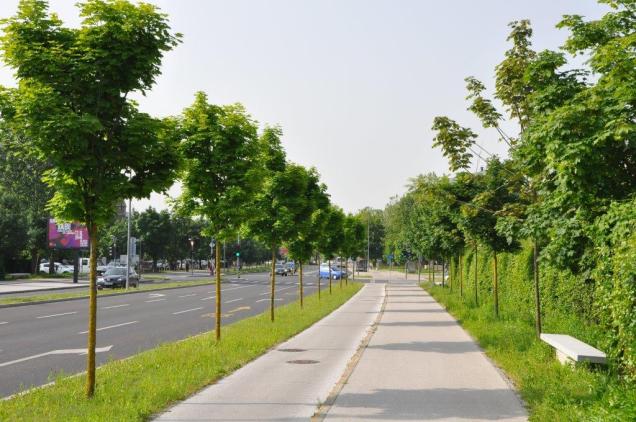Different tree species, growing in different micro-locations were sampled and their tree-ring widths and stable carbon isotope composition in leaf material and tree-rings analysed at the Dendrochronology Laboratory and Laboratory for Stable Isotopes of the Slovenian Forestry Institute. Stem disks of different trees, cut down for safety reasons, were collected by arboristic company Tisa. Also, electronic band dendrometers were used, allowing us to measure daily change with 0.01mm accuracy in girth of the selected trees.

Dendrochronological work
The first step was to build tree-ring width chronology for individual tree species and to compare these chronologies with existing ones of other or same species from surrounding non-urban regions. After each tree-ring is labelled with the year of growth, they were manually cut and further chemically treated to extract pure a-cellulose. This is a very important step when looking at stable carbon isotope composition of tree rings, because only from purified wood component a reliable climate signal can be extracted. After all, trees are exposed to various factors that might enhance or depress their growth, which eventually diminishes climate signal. The reasons can be many – insect attack followed by a viral disease, drought, air pollution, mechanical damage and so on.
Stable carbon isotopes
We also wanted to find out how space limitation, related to insufficient water accumulation near pavement and road surfaces, influences tree physiology. We examined bulk leaf and water soluble organic matter of maple, birch and hornbeam, growing in a non-limited location (lawn strips), 2-side limited location (between pavement and tarmac road) or 4-side limited location (on parking lots or narrow streets). The ratio between heavy and light carbon (13C/12C) is a very good tracer of drought stress. When trees experience it, they close stomata to prevent water loss, but at the same time the production of photosynthates is reduced. This results in narrower tree-rings and higher 13C/12C ratio.
Surprisingly, preliminary results on stable carbon isotope data and other eco-physiological measurements showed that trees, growing in most space-limited areas, are better coping with stress situations compared to trees growing in a non-limited space location. We assume this is related to the rate of photosynthesis of individual trees, however, further analysis will need to be taken.
The WWII, a bullet and a tree
During sample preparation of horse chestnut tree for tree-ring analysis, blade of the table saw cut straight through a bullet, hidden inside the sample. Comparing developed tree-ring chronology and tree-ring counting, we dated the shot back to spring/summer 1944. This is the time of German occupation of Ljubljana, and also the time when numerous arrests occurred at different places in Ljubljana, in one of which, this particular bullet, could be have been shot.

This blog post is authored by dendroclimatologist Dr. Simon Poljanšek, arborist Dr. Lena Marion and isotope biogeochemist Dr. Saša Zavadlav and is part of the #EFUF2016 blog competition.
Acknowledgements: We wish to thank STReESS COST Action: FP1106, and Ministry of Education, Science and Sport for funding the research, Ljubljana City municipality for cooperation in time of trees sampling, Ministry of Foreign Affairs for cooperation in electronic dendrometers measurements, Tisa d.o.o., arboristic company for helping collecting stem disks and National Forensic Laboratory Slovenia for inspecting and sharing the information on the bullet. Saša also acknowledges the funding of the EUFORINNO project (RegPot. No. 315982).